5.7: Divide Polynomials
- Page ID
- 79473
\( \newcommand{\vecs}[1]{\overset { \scriptstyle \rightharpoonup} {\mathbf{#1}} } \)
\( \newcommand{\vecd}[1]{\overset{-\!-\!\rightharpoonup}{\vphantom{a}\smash {#1}}} \)
\( \newcommand{\dsum}{\displaystyle\sum\limits} \)
\( \newcommand{\dint}{\displaystyle\int\limits} \)
\( \newcommand{\dlim}{\displaystyle\lim\limits} \)
\( \newcommand{\id}{\mathrm{id}}\) \( \newcommand{\Span}{\mathrm{span}}\)
( \newcommand{\kernel}{\mathrm{null}\,}\) \( \newcommand{\range}{\mathrm{range}\,}\)
\( \newcommand{\RealPart}{\mathrm{Re}}\) \( \newcommand{\ImaginaryPart}{\mathrm{Im}}\)
\( \newcommand{\Argument}{\mathrm{Arg}}\) \( \newcommand{\norm}[1]{\| #1 \|}\)
\( \newcommand{\inner}[2]{\langle #1, #2 \rangle}\)
\( \newcommand{\Span}{\mathrm{span}}\)
\( \newcommand{\id}{\mathrm{id}}\)
\( \newcommand{\Span}{\mathrm{span}}\)
\( \newcommand{\kernel}{\mathrm{null}\,}\)
\( \newcommand{\range}{\mathrm{range}\,}\)
\( \newcommand{\RealPart}{\mathrm{Re}}\)
\( \newcommand{\ImaginaryPart}{\mathrm{Im}}\)
\( \newcommand{\Argument}{\mathrm{Arg}}\)
\( \newcommand{\norm}[1]{\| #1 \|}\)
\( \newcommand{\inner}[2]{\langle #1, #2 \rangle}\)
\( \newcommand{\Span}{\mathrm{span}}\) \( \newcommand{\AA}{\unicode[.8,0]{x212B}}\)
\( \newcommand{\vectorA}[1]{\vec{#1}} % arrow\)
\( \newcommand{\vectorAt}[1]{\vec{\text{#1}}} % arrow\)
\( \newcommand{\vectorB}[1]{\overset { \scriptstyle \rightharpoonup} {\mathbf{#1}} } \)
\( \newcommand{\vectorC}[1]{\textbf{#1}} \)
\( \newcommand{\vectorD}[1]{\overrightarrow{#1}} \)
\( \newcommand{\vectorDt}[1]{\overrightarrow{\text{#1}}} \)
\( \newcommand{\vectE}[1]{\overset{-\!-\!\rightharpoonup}{\vphantom{a}\smash{\mathbf {#1}}}} \)
\( \newcommand{\vecs}[1]{\overset { \scriptstyle \rightharpoonup} {\mathbf{#1}} } \)
\( \newcommand{\vecd}[1]{\overset{-\!-\!\rightharpoonup}{\vphantom{a}\smash {#1}}} \)
\(\newcommand{\avec}{\mathbf a}\) \(\newcommand{\bvec}{\mathbf b}\) \(\newcommand{\cvec}{\mathbf c}\) \(\newcommand{\dvec}{\mathbf d}\) \(\newcommand{\dtil}{\widetilde{\mathbf d}}\) \(\newcommand{\evec}{\mathbf e}\) \(\newcommand{\fvec}{\mathbf f}\) \(\newcommand{\nvec}{\mathbf n}\) \(\newcommand{\pvec}{\mathbf p}\) \(\newcommand{\qvec}{\mathbf q}\) \(\newcommand{\svec}{\mathbf s}\) \(\newcommand{\tvec}{\mathbf t}\) \(\newcommand{\uvec}{\mathbf u}\) \(\newcommand{\vvec}{\mathbf v}\) \(\newcommand{\wvec}{\mathbf w}\) \(\newcommand{\xvec}{\mathbf x}\) \(\newcommand{\yvec}{\mathbf y}\) \(\newcommand{\zvec}{\mathbf z}\) \(\newcommand{\rvec}{\mathbf r}\) \(\newcommand{\mvec}{\mathbf m}\) \(\newcommand{\zerovec}{\mathbf 0}\) \(\newcommand{\onevec}{\mathbf 1}\) \(\newcommand{\real}{\mathbb R}\) \(\newcommand{\twovec}[2]{\left[\begin{array}{r}#1 \\ #2 \end{array}\right]}\) \(\newcommand{\ctwovec}[2]{\left[\begin{array}{c}#1 \\ #2 \end{array}\right]}\) \(\newcommand{\threevec}[3]{\left[\begin{array}{r}#1 \\ #2 \\ #3 \end{array}\right]}\) \(\newcommand{\cthreevec}[3]{\left[\begin{array}{c}#1 \\ #2 \\ #3 \end{array}\right]}\) \(\newcommand{\fourvec}[4]{\left[\begin{array}{r}#1 \\ #2 \\ #3 \\ #4 \end{array}\right]}\) \(\newcommand{\cfourvec}[4]{\left[\begin{array}{c}#1 \\ #2 \\ #3 \\ #4 \end{array}\right]}\) \(\newcommand{\fivevec}[5]{\left[\begin{array}{r}#1 \\ #2 \\ #3 \\ #4 \\ #5 \\ \end{array}\right]}\) \(\newcommand{\cfivevec}[5]{\left[\begin{array}{c}#1 \\ #2 \\ #3 \\ #4 \\ #5 \\ \end{array}\right]}\) \(\newcommand{\mattwo}[4]{\left[\begin{array}{rr}#1 \amp #2 \\ #3 \amp #4 \\ \end{array}\right]}\) \(\newcommand{\laspan}[1]{\text{Span}\{#1\}}\) \(\newcommand{\bcal}{\cal B}\) \(\newcommand{\ccal}{\cal C}\) \(\newcommand{\scal}{\cal S}\) \(\newcommand{\wcal}{\cal W}\) \(\newcommand{\ecal}{\cal E}\) \(\newcommand{\coords}[2]{\left\{#1\right\}_{#2}}\) \(\newcommand{\gray}[1]{\color{gray}{#1}}\) \(\newcommand{\lgray}[1]{\color{lightgray}{#1}}\) \(\newcommand{\rank}{\operatorname{rank}}\) \(\newcommand{\row}{\text{Row}}\) \(\newcommand{\col}{\text{Col}}\) \(\renewcommand{\row}{\text{Row}}\) \(\newcommand{\nul}{\text{Nul}}\) \(\newcommand{\var}{\text{Var}}\) \(\newcommand{\corr}{\text{corr}}\) \(\newcommand{\len}[1]{\left|#1\right|}\) \(\newcommand{\bbar}{\overline{\bvec}}\) \(\newcommand{\bhat}{\widehat{\bvec}}\) \(\newcommand{\bperp}{\bvec^\perp}\) \(\newcommand{\xhat}{\widehat{\xvec}}\) \(\newcommand{\vhat}{\widehat{\vvec}}\) \(\newcommand{\uhat}{\widehat{\uvec}}\) \(\newcommand{\what}{\widehat{\wvec}}\) \(\newcommand{\Sighat}{\widehat{\Sigma}}\) \(\newcommand{\lt}{<}\) \(\newcommand{\gt}{>}\) \(\newcommand{\amp}{&}\) \(\definecolor{fillinmathshade}{gray}{0.9}\)Learning Objectives
By the end of this section, you will be able to:
- Divide a polynomial by a monomial
- Divide a polynomial by a binomial
Note
Before you get started, take this readiness quiz.
- Add: \(\dfrac{3}{d}+\dfrac{x}{d}\)
If you missed this problem, review Exercise 1.7.1. - Simplify: \(\dfrac{30 x y^{3}}{5 x y}\)
If you missed this problem, review Exercise 6.5.37. - Combine like terms: \(8 a^{2}+12 a+1+3 a^{2}-5 a+4\)
If you missed this problem, review Exercise 1.3.37.
Divide a Polynomial by a Monomial
In the last section, you learned how to divide a monomial by a monomial. As you continue to build up your knowledge of polynomials the next procedure is to divide a polynomial of two or more terms by a monomial.
The method we’ll use to divide a polynomial by a monomial is based on the properties of fraction addition. So we’ll start with an example to review fraction addition.
\(\begin{array}{ll}{\text { The sum, }} & {\dfrac{y}{5}+\dfrac{2}{5}} \\ {\text { simplifies to }} & {\dfrac{y+2}{5}}\end{array}\)
Now we will do this in reverse to split a single fraction into separate fractions.
We’ll state the fraction addition property here just as you learned it and in reverse.
FRACTION ADDITION
If a,b, and c are numbers where \(c\neq 0\), then
\[\dfrac{a}{c}+\dfrac{b}{c}=\dfrac{a+b}{c} \quad \text { and } \quad \dfrac{a+b}{c}=\dfrac{a}{c}+\dfrac{b}{c}\]
We use the form on the left to add fractions and we use the form on the right to divide a polynomial by a monomial.
\(\begin{array}{ll}{\text { For example, }} & {\dfrac{y+2}{5}} \\ {\text { can be written }} & {\dfrac{y}{5}+\dfrac{2}{5}}\end{array}\)
We use this form of fraction addition to divide polynomials by monomials.
DIVISION OF A POLYNOMIAL BY A MONOMIAL
To divide a polynomial by a monomial, divide each term of the polynomial by the monomial.
Exercise \(\PageIndex{1}\)
Find the quotient:\(\dfrac{7 y^{2}+21}{7}\)
- Answer
-
\(\begin{array}{ll} & \dfrac{7 y^{2}+21}{7}\\\text{Divide each term of the numerator by the denominator.} & \dfrac{7 y^{2}}{7}+\dfrac{21}{7} \\ \text {Simplify each fraction. } & y^{2}+3 \end{array}\)
Exercise \(\PageIndex{2}\)
Find the quotient: \(\dfrac{8 z^{2}+24}{4}\)
- Answer
-
\(2 z^{2}+6\)
Exercise \(\PageIndex{3}\)
Find the quotient:\(\dfrac{18 z^{2}-27}{9}\)
- Answer
-
\(2 z^{2}-3\)
Remember that division can be represented as a fraction. When you are asked to divide a polynomial by a monomial and it is not already in fraction form, write a fraction with the polynomial in the numerator and the monomial in the denominator.
Exercise \(\PageIndex{4}\)
Find the quotient: \(\left(18 x^{3}-36 x^{2}\right) \div 6 x\)
- Answer
-
\(\begin{array}{ll} & \left(18 x^{3}-36 x^{2}\right) \div 6 x\\\text { Rewrite as a fraction. } & \dfrac{18 x^{3}-36 x^{2}}{6 x} \\ \text { Divide each term of the numerator by the denominator. }& \dfrac{18 x^{3}}{6 x}-\dfrac{36 x^{2}}{6 x}\\ \text { Simplify. } &3 x^{2}-6 x\end{array}\)
Exercise \(\PageIndex{5}\)
Find the quotient: \(\left(27 b^{3}-33 b^{2}\right) \div 3 b\)
- Answer
-
\(9 b^{2}-11 b\)
Exercise \(\PageIndex{6}\)
Find the quotient: \(\left(25 y^{3}-55 y^{2}\right) \div 5 y\)
- Answer
-
\(5 y^{2}-11 y\)
When we divide by a negative, we must be extra careful with the signs.
Exercise \(\PageIndex{7}\)
Find the quotient: \(\dfrac{12 d^{2}-16 d}{-4}\)
- Answer
-
\(\begin{array}{ll} &\dfrac{12 d^{2}-16 d}{-4}\\ \text { Divide each term of the numerator by the denominator. }& \dfrac{18 x^{3}-36 x^{2}}{6 x} \\ \text { Simplify. Remember, subtracting a negative is like adding a positive! }& -3 d^{2}+4 d\end{array}\)
Exercise \(\PageIndex{8}\)
Find the quotient: \(\dfrac{25 y^{2}-15 y}{-5}\)
- Answer
-
\(-5 y^{2}+3 y\)
Exercise \(\PageIndex{9}\)
Find the quotient: \(\dfrac{42 b^{2}-18 b}{-6}\)
- Answer
-
\(-7 b^{2}+3 b\)
Exercise \(\PageIndex{10}\)
Find the quotient: \(\dfrac{105 y^{5}+75 y^{3}}{5 y^{2}}\)
- Answer
-
\(\begin{array}{ll} &\dfrac{105 y^{5}+75 y^{3}}{5 y^{2}}\\ \text { Separate the terms. }& \dfrac{105 y^{5}}{5 y^{2}}+\dfrac{75 y^{3}}{5 y^{2}}\\ \text { Simplify. }& 21 y^{3}+15 y\end{array}\)
Exercise \(\PageIndex{11}\)
Find the quotient: \(\dfrac{60 d^{7}+24 d^{5}}{4 d^{3}}\)
- Answer
-
\(15 d^{4}+6 d^{2}\)
Exercise \(\PageIndex{12}\)
Find the quotient: \(\dfrac{216 p^{7}-48 p^{5}}{6 p^{3}}\)
- Answer
-
\(36 p^{4}-8 p^{2}\)
Exercise \(\PageIndex{13}\)
Find the quotient: \(\left(15 x^{3} y-35 x y^{2}\right) \div(-5 x y)\)
- Answer
-
\(\begin{array}{ll} &\left(15 x^{3} y-35 x y^{2}\right) \div(-5 x y)\\ \text { Rewrite as a fraction. }& \dfrac{15 x^{3} y-35 x y^{2}}{-5 x y}\\\text { Separate the terms. Be careful with the signs! }& \dfrac{15 x^{3} y}{-5 x y}-\dfrac{35 x y^{2}}{-5 x y}\\ \text { Simplify. } & -3 x^{2}+7 y\end{array}\)
Exercise \(\PageIndex{14}\)
Find the quotient: \(\left(32 a^{2} b-16 a b^{2}\right) \div(-8 a b)\)
- Answer
-
\(-4 a+2 b\)
Exercise \(\PageIndex{15}\)
Find the quotient: \(\left(-48 a^{8} b^{4}-36 a^{6} b^{5}\right) \div\left(-6 a^{3} b^{3}\right)\)
- Answer
-
\(8 a^{5} b+6 a^{3} b^{2}\)
Exercise \(\PageIndex{13}\)
Find the quotient: \(\dfrac{36 x^{3} y^{2}+27 x^{2} y^{2}-9 x^{2} y^{3}}{9 x^{2} y}\)
- Answer
-
\(\begin{array}{ll} &\dfrac{36 x^{3} y^{2}+27 x^{2} y^{2}-9 x^{2} y^{3}}{9 x^{2} y}\\\text { Separate the terms. }& \dfrac{36 x^{3} y^{2}}{9 x^{2} y}+\dfrac{27 x^{2} y^{2}}{9 x^{2} y}-\dfrac{9 x^{2} y^{3}}{9 x^{2} y}\\ \text { Simplify. } & 4 x y+3 y-y^{2}\end{array}\)
Exercise \(\PageIndex{14}\)
Find the quotient: \(\dfrac{40 x^{3} y^{2}+24 x^{2} y^{2}-16 x^{2} y^{3}}{8 x^{2} y}\)
- Answer
-
\(5 x y+3 y-2 y^{2}\)
Exercise \(\PageIndex{15}\)
Find the quotient: \(\dfrac{35 a^{4} b^{2}+14 a^{4} b^{3}-42 a^{2} b^{4}}{7 a^{2} b^{2}}\)
- Answer
-
\(5 a^{2}+2 a^{2} b-6 b^{2}\)
Exercise \(\PageIndex{16}\)
Find the quotient: \(\dfrac{10 x^{2}+5 x-20}{5 x}\)
- Answer
-
\(\begin{array}{ll}&\dfrac{10 x^{2}+5 x-20}{5x}\\\text { Separate the terms. }& \dfrac{10 x^{2}}{5 x}+\dfrac{5 x}{5 x}-\dfrac{20}{5 x}\\ \text { Simplify. } &2 x+1-\dfrac{4}{x}\end{array}\)
Exercise \(\PageIndex{17}\)
Find the quotient: \(\dfrac{18 c^{2}+6 c-9}{6 c}\)
- Answer
-
\(3 c+1-\dfrac{3}{2 c}\)
Exercise \(\PageIndex{18}\)
Find the quotient: \(\dfrac{10 d^{2}-5 d-2}{5 d}\)
- Answer
-
\(2 d-1-\dfrac{2}{5 d}\)
Divide a Polynomial by a Binomial
To divide a polynomial by a binomial, we follow a procedure very similar to long division of numbers. So let’s look carefully the steps we take when we divide a 3-digit number, 875, by a 2-digit number, 25.
| We write the long division |  |
| We divide the first two digits, 87, by 25. |  |
| We multiply 3 times 25 and write the product under the 87. |  |
| Now we subtract 75 from 87. |  |
| Then we bring down the third digit of the dividend, 5. |  |
| Repeat the process, dividing 25 into 125. |  |
We check division by multiplying the quotient by the divisor.
If we did the division correctly, the product should equal the dividend.
\[\begin{array}{l}{35 \cdot 25} \\ {875}\checkmark\end{array}\]
Now we will divide a trinomial by a binomial. As you read through the example, notice how similar the steps are to the numerical example above.
Exercise \(\PageIndex{19}\)
Find the quotient: \(\left(x^{2}+9 x+20\right) \div(x+5)\)
- Answer
-

Write it as a long division problem. Be sure the dividend is in standard form. 
Divide x2 by x. It may help to ask yourself, "What do I need to multiply x by to get x2?" Put the answer, x, in the quotient over the x term. 
Multiply x times x + 5. Line up the like terms under the dividend. 
Subtract x2 + 5x from x2 + 9x. 
Then bring down the last term, 20.
Divide 4x by x. It may help to ask yourself, "What do I need to
multiply x by to get 4x?"Put the answer, 4, in the quotient over the constant term. 
Multiply 4 times x + 5. 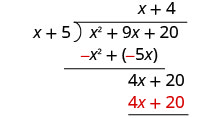
Subtract 4x + 20 from 4x + 20. 
Check: Multiply the quotient by the divisor. (x + 4)(x + 5) You should get the dividend. x2 + 9x + 20✓
Exercise \(\PageIndex{20}\)
Find the quotient: \(\left(y^{2}+10 y+21\right) \div(y+3)\)
- Answer
-
y+7
Exercise \(\PageIndex{21}\)
Find the quotient: \(\left(m^{2}+9 m+20\right) \div(m+4)\)
- Answer
-
m+5
When the divisor has subtraction sign, we must be extra careful when we multiply the partial quotient and then subtract. It may be safer to show that we change the signs and then add.
Exercise \(\PageIndex{22}\)
Find the quotient: \(\left(2 x^{2}-5 x-3\right) \div(x-3)\)
- Answer
-

Write it as a long division problem. Be sure the dividend is in standard form. 
Divide 2x2 by x.
Put the answer, 2x, in the quotient over the x term.
Multiply 2x times x − 3. Line up the like terms under the dividend. 
Subtract 2x2 − 6x from 2x2 − 5x.
Change the signs and then add.
Then bring down the last term.
Divide x by x.
Put the answer, 1, in the quotient over the constant term.
Multiply 1 times x − 3. 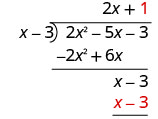
Subtract x − 3 from x − 3 by changing the signs and adding. 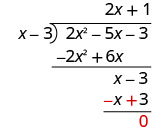
To check, multiply (x − 3)(2x + 1). The result should be 2x2 − 5x − 3.
Exercise \(\PageIndex{23}\)
Find the quotient: \(\left(2 x^{2}-3 x-20\right) \div(x-4)\)
- Answer
-
2x+5
Exercise \(\PageIndex{24}\)
Find the quotient: \(\left(3 x^{2}-16 x-12\right) \div(x-6)\)
- Answer
-
3x+2
When we divided 875 by 25, we had no remainder. But sometimes division of numbers does leave a remainder. The same is true when we divide polynomials. In Exercise \(\PageIndex{25}\), we’ll have a division that leaves a remainder. We write the remainder as a fraction with the divisor as the denominator.
Exercise \(\PageIndex{25}\)
Find the quotient: \(\left(x^{3}-x^{2}+x+4\right) \div(x+1)\)
- Answer
-

Write it as a long division problem. Be sure the dividend is in standard form. 
Divide x3 by x.
Put the answer, x2, in the quotient over the x2 term.
Multiply x2 times x + 1. Line up the like terms under the dividend.
Subtract x3 + x2 from x3 − x2 by changing the signs and adding.
Then bring down the next term.
Divide −2x2 by x.
Put the answer, −2x, in the quotient over the x term.
Multiply −2x times x + 1. Line up the like terms under the dividend.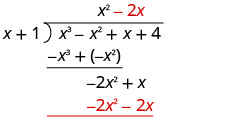
Subtract −2x2 − 2x from −2x2 + x by changing the signs and adding.
Then bring down the last term.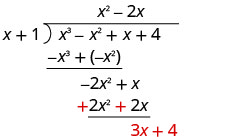
Divide 3x by x.
Put the answer, 3, in the quotient over the constant term.
Multiply 3 times x + 1. Line up the like terms under the dividend.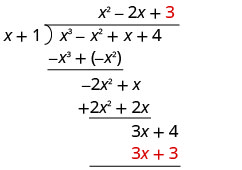
Subtract 3x + 3 from 3x + 4 by changing the signs and adding.
Write the remainder as a fraction with the divisor as the denominator.
The result should be \(x^{3}-x^{2}+x+4\)
Exercise \(\PageIndex{26}\)
Find the quotient: \(\left(x^{3}+5 x^{2}+8 x+6\right) \div(x+2)\)
- Answer
-
\(x^{2}+3 x+2+\dfrac{2}{x+2}\)
Exercise \(\PageIndex{27}\)
Find the quotient: \(\left(2 x^{3}+8 x^{2}+x-8\right) \div(x+1)\)
- Answer
-
\(2 x^{2}+6 x-5-\dfrac{3}{x+1}\)
Look back at the dividends in Example, Example, and Example. The terms were written in descending order of degrees, and there were no missing degrees. The dividend in Example will be \(x^{4}-x^{2}+5 x-2\). It is missing an \(x^{3}\) term. We will add in \(0x^{3}\) as a placeholder.
Exercise \(\PageIndex{28}\)
Find the quotient: \(\left(x^{4}-x^{2}+5 x-2\right) \div(x+2)\)
- Answer
-
Notice that there is no \(x^{3}\) term in the dividend. We will add \(0x^{3}\) as a placeholder.

Write it as a long division problem. Be sure the dividend is in standard form with placeholders for missing terms. 
Divide x4 by x.
Put the answer, x3, in the quotient over the x3 term.
Multiply x3 times x + 2. Line up the like terms.
Subtract and then bring down the next term.
Divide −2x3 by x.
Put the answer, −2x2, in the quotient over the x2 term.
Multiply −2x2 times x + 1. Line up the like terms.
Subtract and bring down the next term.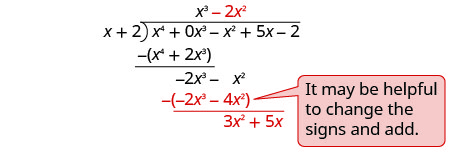
Divide 3x2 by x.
Put the answer, 3x, in the quotient over the x term.
Multiply 3x times x + 1. Line up the like terms.
Subtract and bring down the next term.
Divide −x by x.
Put the answer, −1, in the quotient over the constant term.
Multiply −1 times x + 1. Line up the like terms.
Change the signs, add.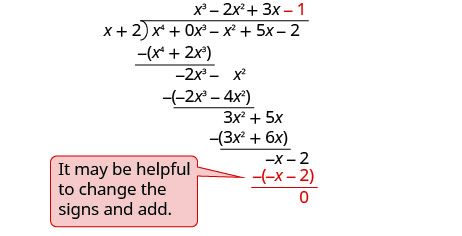
The result should be \(x^{4}-x^{2}+5 x-2\)
Exercise \(\PageIndex{29}\)
Find the quotient: \(\left(x^{3}+3 x+14\right) \div(x+2)\)
- Answer
-
\(x^{2}-2 x+7\)
Exercise \(\PageIndex{30}\)
Find the quotient: \(\left(x^{4}-3 x^{3}-1000\right) \div(x+5)\)
- Answer
-
\(x^{3}-8 x^{2}+40 x-200\)
In Exercise \(\PageIndex{31}\), we will divide by \(2a−3\). As we divide we will have to consider the constants as well as the variables.
Exercise \(\PageIndex{31}\)
Find the quotient: \(\left(8 a^{3}+27\right) \div(2 a+3)\)
- Answer
-
This time we will show the division all in one step. We need to add two placeholders in order to divide.
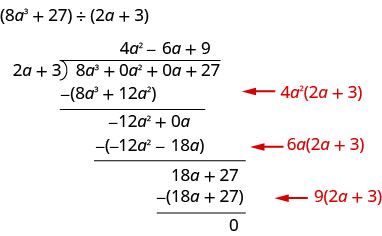
To check, multiply \((2 a+3)\left(4 a^{2}-6 a+9\right)\)
The result should be \(8 a^{3}+27\)
Exercise \(\PageIndex{32}\)
Find the quotient: \(\left(x^{3}-64\right) \div(x-4)\)
- Answer
-
\(x^{2}+4 x+16\)
Exercise \(\PageIndex{33}\)
Find the quotient: \(\left(125 x^{3}-8\right) \div(5 x-2)\)
- Answer
-
\(25 x^{2}+10 x+4\)
Note
Access these online resources for additional instruction and practice with dividing polynomials:
Key Concepts
- Fraction Addition
- If a,b, and c are numbers where \(c\neq 0\), then
\(\dfrac{a}{c}+\dfrac{b}{c}=\dfrac{a+b}{c}\) and \(\dfrac{a+b}{c}=\dfrac{a}{c}+\dfrac{b}{c}\)
- If a,b, and c are numbers where \(c\neq 0\), then
- Division of a Polynomial by a Monomial
- To divide a polynomial by a monomial, divide each term of the polynomial by the monomial.


